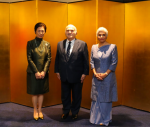You are here
How to save the pandemic treaty
Apr 05,2024 - Last updated at Apr 05,2024
Achieving both requires rewriting the rules of how health and well-being are valued, produced, and distributed and how economies are governed. The treaty’s success will depend on member states’ willingness to hardwire equity into its terms. And that, in turn, will require a new economic paradigm. If the treaty is whittled down to become as inoffensive as possible, it will fail.
The World Health Organisation Council on the Economics of Health for All, which I chaired, has already issued recommendations for how to proceed. For starters, negotiators from all countries must remain focused on the overarching goal of preventing future health threats from becoming catastrophic. That means designing the terms of the treaty, including those related to innovation, intellectual property (IP), public-private collaboration and funding, to be mission-oriented. Equity must be the top priority, because everyone and every economy, ultimately suffers in a pandemic if tests, vaccines and lifesaving therapeutics are not accessible to all.
Moreover, how innovation and knowledge are governed is as critical as the innovation itself. Governments have powerful levers for determining who benefits from innovation. They are major funders of everything from early-stage research and development to product development and manufacturing. The mRNA COVID-19 vaccines, for example, benefited from about $31.9 billion in US public investment. Stronger conditions on private-sector access to public funding would help to ensure equitable and affordable access to the resulting products, as well as facilitating profit sharing and reinvestment in productive activities (like R&D) rather than unproductive ones (like shareholder buybacks).
The point, in each case, is to establish a more symbiotic relationship with the private sector — one based on shared goals, and on shared risks and rewards. As we saw with the repeated spread of new COVID-19 variants, a vaccine that only some can afford will not stop a pandemic. Any pandemic treaty should unapologetically commit to this shift and avoid clauses designed to serve private rent-seeking interests.
A key part of getting public-private collaboration right is to establish an approach to knowledge governance and IP rights that serves the common good, rather than protecting monopoly profits. This issue has become a major flashpoint in the treaty negotiations. Lower-income countries are being asked to share pathogen data (which aids the development of new tests, vaccines, and treatments) without any guarantee that they will have access to the resulting products.
While the current draft alludes to the importance of IP rules that do not limit affordability and access, it merely “encourages”, rather than requires, measures aimed at knowledge sharing and limiting royalties. Even weak language asking governments to “consider supporting” patent waivers has become a sticking point.
This suggests that a misplaced drive to preserve current IP rules is complicating the negotiations. To incentivise innovation and deliver broadly shared societal benefits, patents must be narrower; they must encourage productive follow-on innovation and collective intelligence; and they must be accompanied by commitments to transfer the knowledge and technology required for production.
Another obstacle to the pandemic treaty’s success is that it currently seems to be delinked from clear funding commitments. The International Monetary Fund estimates that the global economy suffered losses of at least $13.8 trillion as COVID-19 lockdowns and supply-chain disruptions tipped the world into recession. Governments then spent trillions more responding to the crisis. It should be obvious that scaling up investments in prevention is preferable, in terms of health, prosperity, and justice, to incurring the costs from a crisis that has spun out of control. As the WHO council pointed out, “it is more cost effective to prevent than to cure”.
The quality of financing is as important as its quantity. Lower-income countries need long-term financing for critical investments in health. The treaty’s nod to the importance of debt relief to free up fiscal capacity for pandemic prevention, preparedness, and response is welcome, but the language is worryingly noncommittal. Financing for health must be understood as a long-term investment, rather than as a cost that can be reduced to serve short-sighted budget targets. It is also a responsibility that transcends national borders.
Lastly, since the scope of the pandemic treaty cuts across government ministries and sectors, health should not be left solely to health ministries. Health is massively impacted by economic policy choices (for example, related to IP rights), and decisions across government impact the social, environmental, and economic determinants of health. Governments, across all ministries, can and should redesign how innovation is governed, how the public and private sectors relate to one another, and how finance is structured to shape markets in the interest of human and planetary health. Failure to prioritise “health for all” will have far-reaching ramifications for the resilience and stability of economies worldwide.
As member states cavil over clauses, removing references to health as a human right and watering down IP restrictions, financial commitments, and monitoring provisions, there should be no ambiguity about the choice they face. Centering the treaty on the goal of preventing or minimising pandemics would compel policymakers to see it clearly, and to abandon the myopic assumptions that have limited international and public-private collaboration. As member states prepare for the World Health Assembly in May, this imperative should be front of mind.
Mariana Mazzucato, founding director of the UCL Institute for Innovation and Public Purpose, is chair of the World Health Organisation’s Council on the Economics of Health for All. Copyright: Project Syndicate, 2024. www.project-syndicate.org














Add new comment